|
Fabulous Fabergé
by Bob Brooke
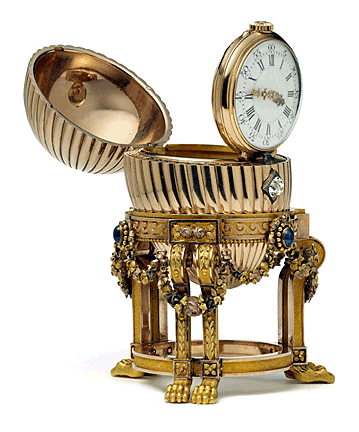 A
story of Imperial Russia as romantic as Doctor Zhivago and as tragic
as War and Peace surrounds a golden egg. No, not the one the goose
laid, but one designed and crafted in solid gold by Peter Carl
Fabergé, goldsmith to royalty. A
story of Imperial Russia as romantic as Doctor Zhivago and as tragic
as War and Peace surrounds a golden egg. No, not the one the goose
laid, but one designed and crafted in solid gold by Peter Carl
Fabergé, goldsmith to royalty.
For 112 years, this egg was thought to be lost. It appeared on
official inventories just after the Russian Revolution but then
mysteriously disappeared until someone purchased it for a mere
$13,302 at a Midwestern antiques mart. Ironically, the buyer didn’t
purchase it for the egg but for the luxurious Vacheron & Constantin
ladies watch inside. The buyer thought the egg was just the watch’s
storage container and had planned on melting it down.
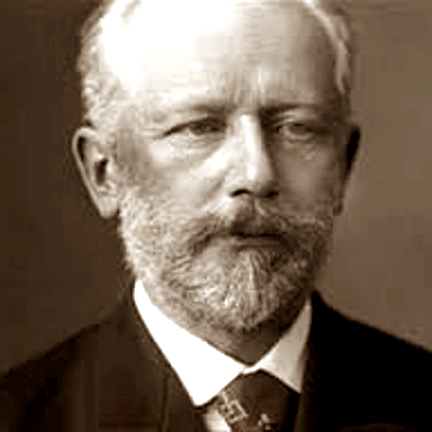 To
find out more about the watch, the buyer did a search on Google and
discovered to his amazement that what he had purchased was in fact
an 1887 birthday gift for Czar Alexander III from Fabergé, himself.
He subsequently put it up for auction with Sotheby’s where it sold
for an estimated $33 million, making it the most expensive watch—and
consequently Faberge egg—in the world. To
find out more about the watch, the buyer did a search on Google and
discovered to his amazement that what he had purchased was in fact
an 1887 birthday gift for Czar Alexander III from Fabergé, himself.
He subsequently put it up for auction with Sotheby’s where it sold
for an estimated $33 million, making it the most expensive watch—and
consequently Faberge egg—in the world.
The egg, made in 1887, was the third of 54 Fabergé eggs owned by the
Romanovs, the Russian royal family, and had been lost since 1922.
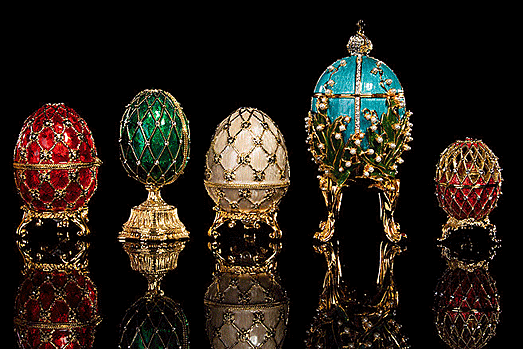
The Provisional Russian Government recorded the egg among the
confiscated Imperial treasures transferred from the Anichkov Palace to
the Moscow Kremlin Armory in September 1917. Although historians believe
some of the eggs had been stolen.
Then in 1922, the Provisional Russian Government transferred this egg,
along with ____ others, from the Kremlin Armory, which had confiscated
the eggs in 1917 when the Czar was overthrown, to the special
plenipotentiary of the Council of People's Commissars, Ivan Gavrilovich
Chinariov. Besides the written inventories, a photograph of the egg
taken in 1902 when it was on exhibit in St. Petersburg also survived.
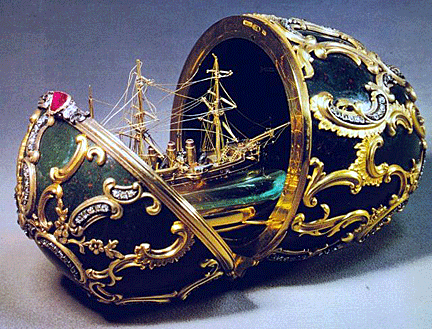 The
jeweled and ridged yellow gold egg stands on its original tripod
pedestal, which has chased lion paw feet. Colored gold garlands
suspended from cabochon blue sapphires topped with rose diamond set bows
encircle it. The
jeweled and ridged yellow gold egg stands on its original tripod
pedestal, which has chased lion paw feet. Colored gold garlands
suspended from cabochon blue sapphires topped with rose diamond set bows
encircle it.
Each Faberge egg contains a “surprise,” a miniature sculpture or object
that illustrates the theme of the egg. The third egg’s surprise is a
lady’s pendant watch by Vacheron Constantin, with a white enamel dial
and openwork diamond set gold hands. Faberge took the watch out of its
case and mounted it in the egg, hinging it so that it could stand
upright.
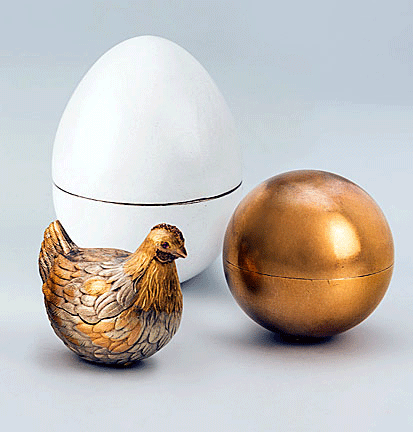 Czar
Alexander III, who had decided to give his wife, the Empress Maria
Feodorovna, an Easter egg in 1885, possibly to celebrate the 20th
anniversary of their betrothal. Although there is no official record of
the Czar's inspiration for it, many believe that an egg owned by the
Empress's aunt, Princess Vilhelmine Marie of Denmark, which had
captivated Maria's imagination in her childhood and of which the Czar
was well aware, was the inspiration for this tradition. Known as the Hen
Egg, the very first Fabergé egg is crafted from a foundation of gold.
Its opaque white enameled "shell" opens to reveal a matte yellow-gold
yolk. This, in turn, opens to reveal a multicolored gold hen that also
opens. The hen contained a minute diamond replica of the imperial crown
from which a small ruby pendant was suspended, but these last two
elements have been lost. Czar
Alexander III, who had decided to give his wife, the Empress Maria
Feodorovna, an Easter egg in 1885, possibly to celebrate the 20th
anniversary of their betrothal. Although there is no official record of
the Czar's inspiration for it, many believe that an egg owned by the
Empress's aunt, Princess Vilhelmine Marie of Denmark, which had
captivated Maria's imagination in her childhood and of which the Czar
was well aware, was the inspiration for this tradition. Known as the Hen
Egg, the very first Fabergé egg is crafted from a foundation of gold.
Its opaque white enameled "shell" opens to reveal a matte yellow-gold
yolk. This, in turn, opens to reveal a multicolored gold hen that also
opens. The hen contained a minute diamond replica of the imperial crown
from which a small ruby pendant was suspended, but these last two
elements have been lost.
The egg delighted the Empress so much that the Czar commissioned another
Easter egg for her the following year. He also appointed Fabergé a
“Goldsmith by special appointment to the Imperial Crown.” The second egg
also featured a hen, and is known as the Hen with Sapphire Pendant. From
then on, the Czar commissioned an egg for his wife each Easter. He gave
Fabergé complete creative freedom over the design of each one. The
tradition became so established within the Russian Royal Family that
when Czar Alexander III died in 1894, his son, Nicholas II, continued to
commission eggs each year—one for his own wife, and one for his mother,
the Dowager Empress.
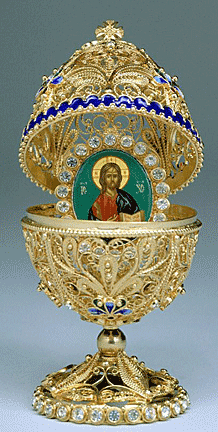 These
bejeweled eggs, possibly numbering as many as 69, of which 57 survive
today, created by the House of Fabergé, in St. Petersburg were
manufactured under the supervision of Peter Carl Fabergé between 1885
and 1917, the most famous being the 54 "Imperial" eggs, 43 of which
survive, made for the Russian Czars Alexander III and Nicholas II as
Easter gifts for their wives and mothers. These
bejeweled eggs, possibly numbering as many as 69, of which 57 survive
today, created by the House of Fabergé, in St. Petersburg were
manufactured under the supervision of Peter Carl Fabergé between 1885
and 1917, the most famous being the 54 "Imperial" eggs, 43 of which
survive, made for the Russian Czars Alexander III and Nicholas II as
Easter gifts for their wives and mothers.
After Alexander III's death on November 1, 1894, his son, Nicholas II,
presented a Fabergé egg to both his wife, Alexandra Fedorovna, and his
mother, the Dowager Empress Maria Fedorovna. Records have shown that of
the 50 imperial Easter eggs, 20 were given to the former and 30 to the
latter. Eggs were made each year except 1904 and 1905, during the
Russo-Japanese War.
As Fabergé promised, each egg was entirely unique and reflected the
fashions of the day. For example, Art Nouveau featured heavily in the
1898 egg, “Lilies of the Valley”. This egg’s surprise, revealed by
twisting a gold-mounted pearl button, was three portraits set under the
Imperial crown: Czar Nicholas II and his two oldest daughters, the Grand
Duchesses Olga and Tatiana.
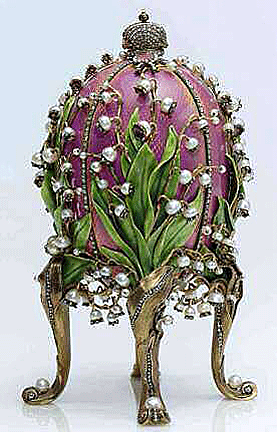 The
supervising goldsmith for the “Lilies of the Valley” egg was Michael
Perchin. It was presented on April 5, 1898 to Czar Nicholas II, who gave
it to Czaritsa, Empress Alexandra Fyodorovna. The
supervising goldsmith for the “Lilies of the Valley” egg was Michael
Perchin. It was presented on April 5, 1898 to Czar Nicholas II, who gave
it to Czaritsa, Empress Alexandra Fyodorovna.
Designed by Alma Pihl, the only female and one of the best known Fabergé
workmasters, the egg;s exterior resembles frost and ice crystals formed
on clear glass. Made from quartz, platinum, and orthoclase, it is
studded with 1,660 diamonds. The surprise is a miniature flower basket,
made from gold and platinum and studded with 1,378 diamonds, with
flowers made of white quartz and leaves made of demantoid. The flowers
lie in a bed of gold moss.
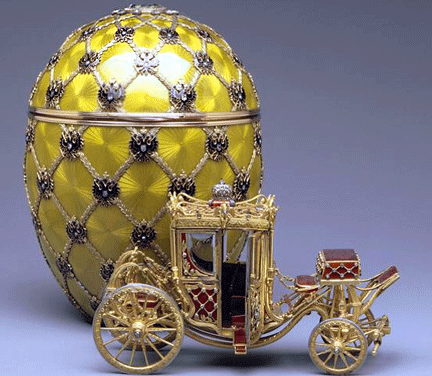 Other
notable designs include the Imperial Coronation egg, made in 1897, and
an egg commemorating Alexander III made for the Dowager Empress in 1909.
The former contains a precise miniature version of the 18th-century
Imperial coach that carried the Czarina to her coronation. This coach is
complete with moving wheels, opening doors and a tiny step-stair. The
commemorative egg, perhaps unsurprisingly, contained a miniature gold
bust of the late Czar. It’s one of four eggs that commemorate his reign. Other
notable designs include the Imperial Coronation egg, made in 1897, and
an egg commemorating Alexander III made for the Dowager Empress in 1909.
The former contains a precise miniature version of the 18th-century
Imperial coach that carried the Czarina to her coronation. This coach is
complete with moving wheels, opening doors and a tiny step-stair. The
commemorative egg, perhaps unsurprisingly, contained a miniature gold
bust of the late Czar. It’s one of four eggs that commemorate his reign.
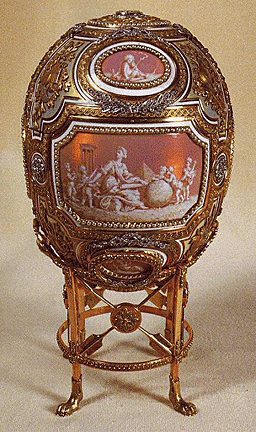 The
Grisaille Egg, also known as the "Catherine the Great Egg," made in 1914
by Henrik Wigström, Fabergé's last head workmaster, was a gift from Czar
Nicholas II to his mother Maria Feodorovna. Its surprise (now lost) was
a mechanical The
Grisaille Egg, also known as the "Catherine the Great Egg," made in 1914
by Henrik Wigström, Fabergé's last head workmaster, was a gift from Czar
Nicholas II to his mother Maria Feodorovna. Its surprise (now lost) was
a mechanical
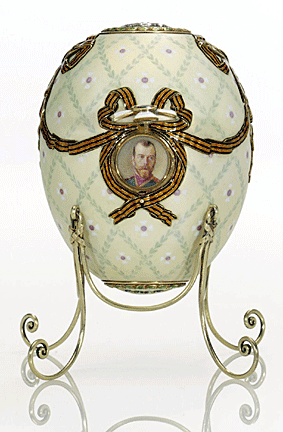 sedan
chair, carried by two blackamoors, with Catherine the Great seated
inside. sedan
chair, carried by two blackamoors, with Catherine the Great seated
inside.
The Order of St. George Egg, made during World War I, commemorated the
Order of St. George, awarded to Emperor Nicholas II and his son, the
Grand Duke Alexei Nikolaievich. The Order of St. George Egg and its
counterpart the Steel Military Egg were given a modest design in keeping
with the austerity of World War I. The Order of St. George egg left
Bolshevik Russia with its original recipient, the Dowager Empress Maria
Feodorovna.
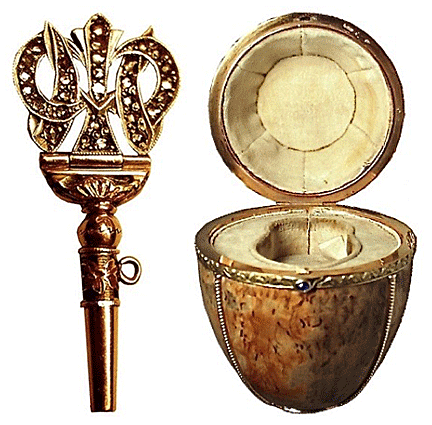 The
Karelian Birch Egg, created in 1917, was due to be completed and
delivered to Czar Nicholas II that Easter, as a present for his mother,
the Empress Maria Feodorovna. Before the egg could be delivered, the
February Revolution took place and he
was forced to abdicate his throne on March 15. On
April 25, Fabergé sent the Czar an invoice for the egg, addressing
Nicholas II not as "Czar of all the Russians" but as "Mr. Romanov,
Nikolai Aleksandrovich". Faberge sent the egg to Grand Duke Michael
Alexandrovich at his palace, for presentation to the Empress, but the
Duke fled before it arrived. The egg remained in the palace until
someone stole it in the wake of the October Revolution later that year. The
Karelian Birch Egg, created in 1917, was due to be completed and
delivered to Czar Nicholas II that Easter, as a present for his mother,
the Empress Maria Feodorovna. Before the egg could be delivered, the
February Revolution took place and he
was forced to abdicate his throne on March 15. On
April 25, Fabergé sent the Czar an invoice for the egg, addressing
Nicholas II not as "Czar of all the Russians" but as "Mr. Romanov,
Nikolai Aleksandrovich". Faberge sent the egg to Grand Duke Michael
Alexandrovich at his palace, for presentation to the Empress, but the
Duke fled before it arrived. The egg remained in the palace until
someone stole it in the wake of the October Revolution later that year.
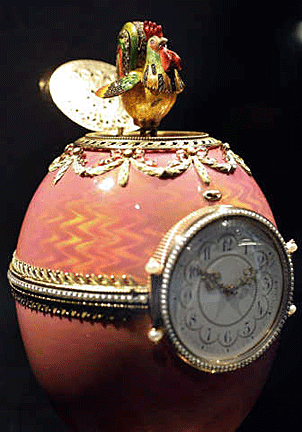 The
Imperial Fabergé eggs created quite a stir high society circles at the
turn of the century. A few Russian and European aristocrats commissioned
Fabergé to make similar eggs for them. Notable clients included the
Duchess of Marlborough and the Rothschild family. Fabergé was also
commissioned by nobleman and industrialist Alexander Kelch, who asked
the jeweler to make a number of eggs for his wife. None of these eggs
are as elaborately designed as the Imperial eggs. However, they do
follow the same pattern of hiding a surprise inside. The
Imperial Fabergé eggs created quite a stir high society circles at the
turn of the century. A few Russian and European aristocrats commissioned
Fabergé to make similar eggs for them. Notable clients included the
Duchess of Marlborough and the Rothschild family. Fabergé was also
commissioned by nobleman and industrialist Alexander Kelch, who asked
the jeweler to make a number of eggs for his wife. None of these eggs
are as elaborately designed as the Imperial eggs. However, they do
follow the same pattern of hiding a surprise inside.
Fabergé made all his eggs from precious metals and gemstones, so for
this reason alone it's no surprise that they're the most expensive eggs
in the world.
<
Back to More Antique Spotlights
Next Article >
|
